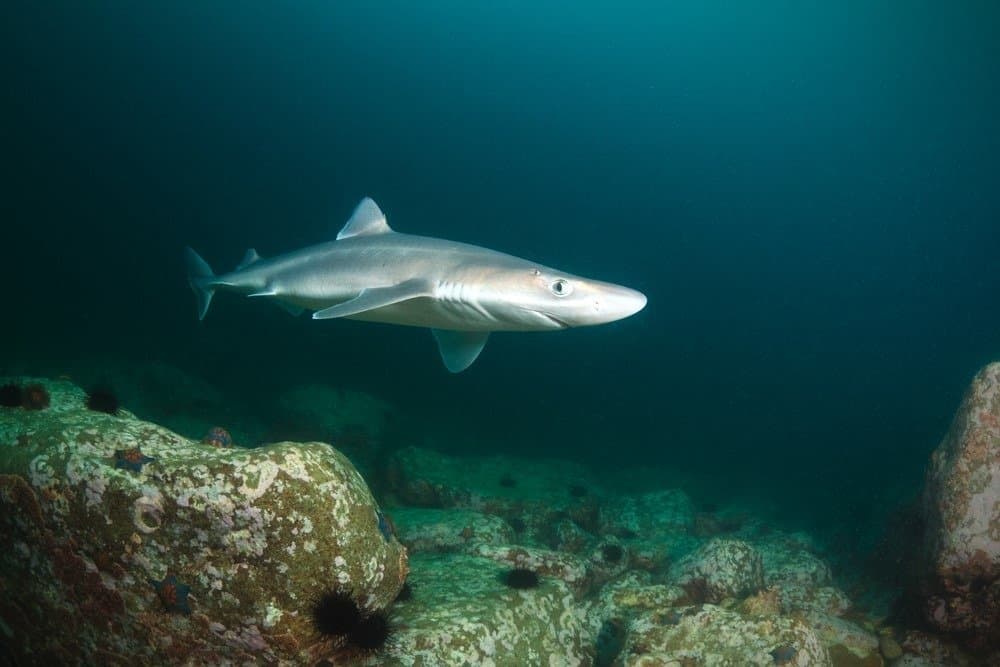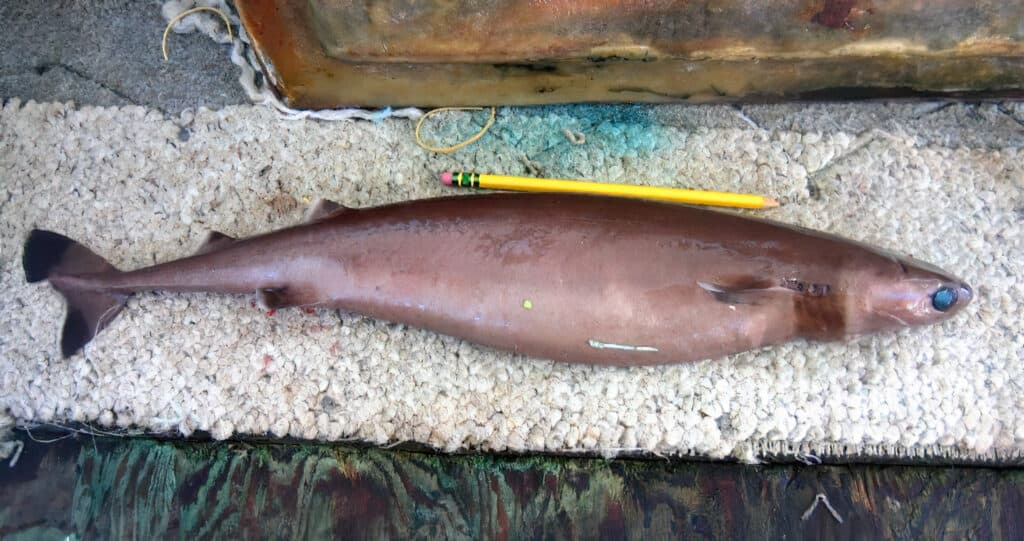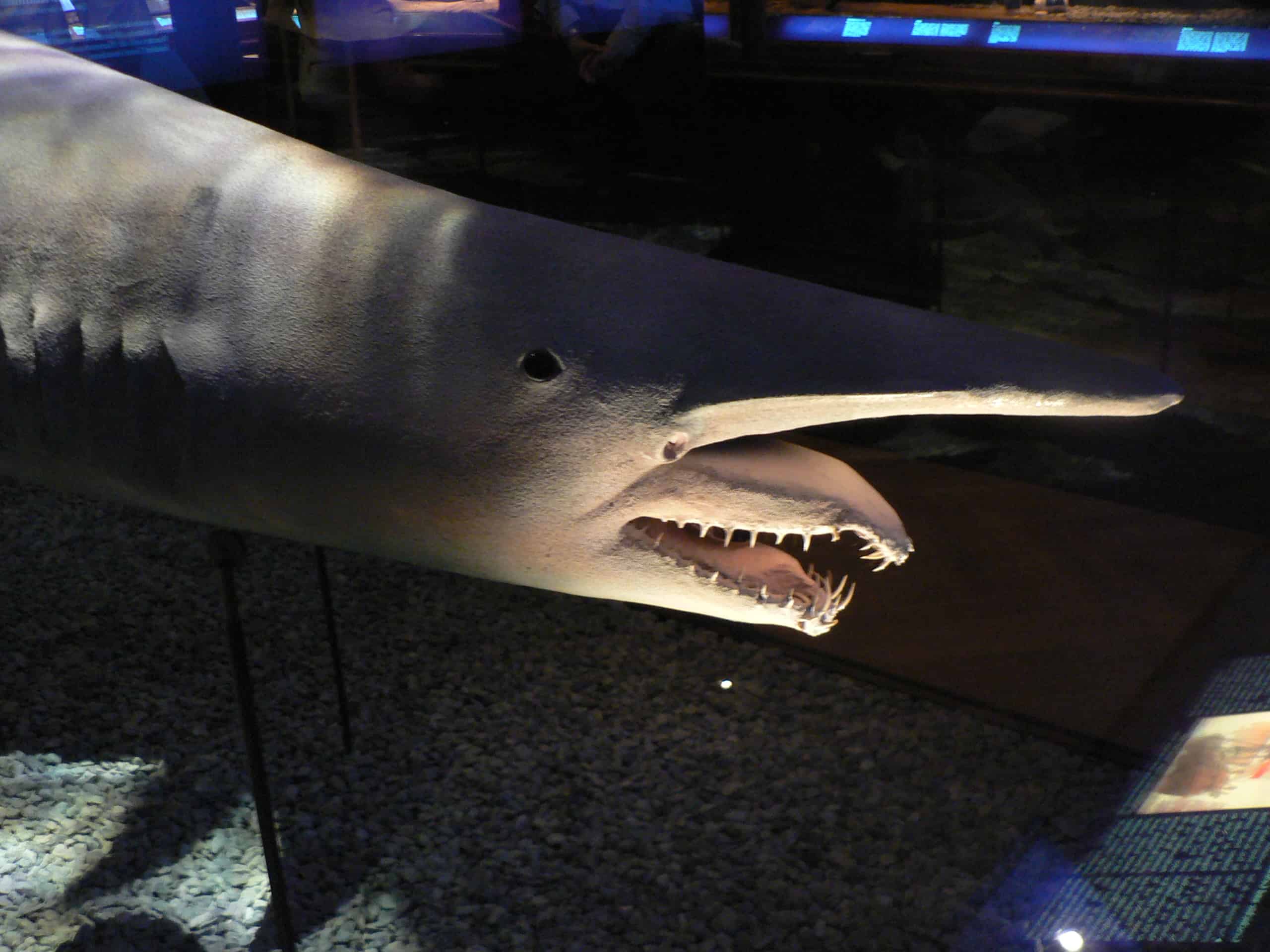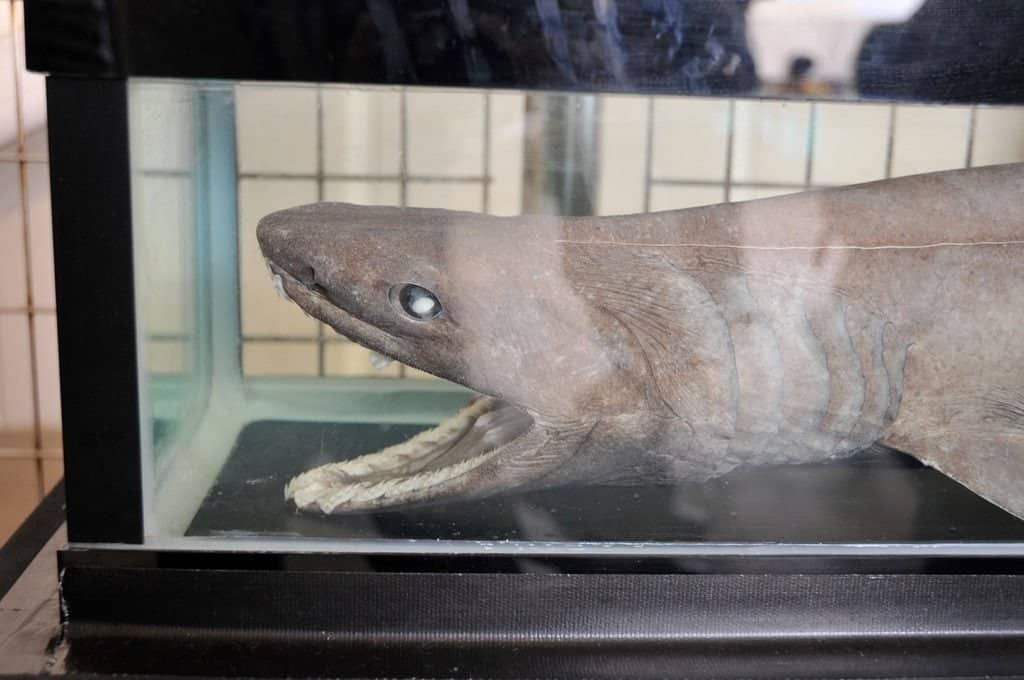There are over 500 shark species in the sea. Some sharks are some of the largest fish in the ocean, while others are small and ferocious. This article will take a look at 6 types of sharks with the weirdest adaptations. Even with their similarities, sharks can vary greatly from each other, and some have some of the weirdest traits in the animal kingdom.
Sharks have swum the earth’s oceans for 450 million years, and continue to do so today. What has helped sharks survive so long is the way they have evolved to adapt to their environment. Sharks come in all different sizes and have many traits that have allowed them to thrive in their respective habitats. Let’s take a look at 6 sharks with weird adaptations that help with their daily life in the ocean.
1. Spiny Dogfish Shark

Spiny dogfish shark, deep – 15 meters, sea of japan, Russia
©Boris Pamikov/Shutterstock.com
The spiny dogfish shark is a small species, usually growing around 39 inches (99 cm) large. An average-looking shark, this species spends its time swimming in the ocean at various depths and swims in a school with other sharks of similar size.
To defend itself, this shark has two venomous spines at the front of both of its dorsal fins. These sharp and venomous spines help protect them from the various predators of the sea they come across such as larger sharks, orcas, tunas, and even humans. While not the weirdest adaptation found in a shark, dogfish sharks are one of the few venomous species of shark in the world, as it is rare for sharks to possess this rare adaptation.
2. Longnose Sawshark

Sawtooth shark posing on the bottom of the sea
©Chaos2Light Images/Shutterstock.com
Saw sharks are named after their elongated snout, which has 19 to 25 teeth that stick out of their face.
There are currently only 10 species of saw shark:
- Warren’s Sixgill Sawshark (Pilotrema warreni)
- Longnose Sawshark (Pristiophorus cirratus)
- Tropical Sawshark (Pristiophorus delicatus)
- Japanese Sawshark (Pristiophorus japonicus)
- Lana’s Sawshark (Pristiophorus lanae)
- African Sawshark (Pristiophorus nancyae)
- Shortnose Sawshark (Pristiophorus nudipinnis)
- Bahamas Sawshark (Pristiophorus schroederi)
- Anna’s Sawshark (Pilotrema annae)-Extinct
- Kaja’s Sawshark (Pilotrema kajae)-Extinct
The longnose saw shark is the largest of all species and has a max length of 4.6 feet (1.37 meters). The sword on this shark’s face is not just for looks but a useful hunting tool. By using fast movements and swinging its snout side to side quickly, this shark can quickly neutralize prey like small fish and crustaceans.
These sharks should not be confused for the very similar sawfish, which are not sharks. Saw sharks can replace the saws on the snout since their teeth are replaceable and do not grow as large as sawfish. Saw sharks are also actually sharks, while sawfish are classified as rays.
3. Cookiecutter Shark

Cookiecutter shark (Isistius brasiliensis)
©NOAA Observer Project / public domain – License
A deep sea shark not seen often, cookiecutter sharks first came into the spotlight in 2009, when one first bit a long-distance swimmer. Unlike other shark bites which leave bloody wounds, this shark left a circular-shaped indentation in the area it bit.
Cookiecutter sharks are able to feed on large prey like dolphins, other sharks, large fish, and seals. This shark literally takes a bite out of its prey, leaving a circular-shaped wound as a cookie cutter would leave in the dough. The average bite wound from this shark is around 2 cm wide and 7 cm deep. The lips of this shark and its upper teeth are used to attach to their prey. This shark rips the flesh of its prey with its bottom teeth.
As a deep sea shark, this species goes up to the surface to feed at night. Another unique adaptation this shark has is the ability to make its belly glow. This helps it hide from prey below and makes fish think its stomach is the glowing moon, allowing them to get close to their prey easily. This small species reaches a maximum size of around 22 inches and is sometimes called the cigar shark due to its brown coloring.
4. Great Hammerhead Shark

Hammerheads are named according to the shape of their head.
©HakBak/Shutterstock.com
Hammerhead sharks are known for their odd-shaped heads, and the great hammerhead is the largest. This shark can grow up to 20 feet in length and can weigh up to 1,000 lbs. The head shape of the hammerhead shark is not a useless weird adaptation but gives this shark the best range of vision among all other sharks in the ocean. With the shape of the hammerhead shark’s eyes and eye placement, this shark is able to get a 360-degree view of its surroundings with stereo vision.
Animals like fish, squid, and crustaceans are what this species feeds on, and they actively seek out prey. The eyesight and size of the great hammerhead shark make them one of the ocean’s fiercest predators, and their mallet heads are just one interesting thing about this shark.
5. Goblin Shark

The goblin shark has a protruding snout.
©Peter Halasz / CC BY-SA 3.0 – License
The goblin shark gets its name from its gnarly appearance, which looks similar to the traditional Japanese representation of a goblin. This large species grows to around 13 feet long and weighs up to 460 lbs. The protruding snout from this shark is its most identifiable trait but also helps it survive its deep-sea lifestyle.
Goblin sharks can thrust their jaw around 9 percent of their total body length at a quick rate of approximately 3.1 meters per second. By protruding their jaws, goblin sharks feed on prey like fish or squid. This maneuver helps grip their prey and chow it down. The large snout of the goblin shark also has a purpose, as it is where their electricity sensing organ is located.
6. Frilled Shark

Frilled shark in museum
©saname777 from Tokyo, Japan / CC BY 2.0 – License
Rarely seen by humans, frilled sharks are species that live in waters on the continental shelf. The body shape of this shark is different from most other species. Frilled sharks have an elongated body shaped more similarly to an eel, which gives them a prehistoric appearance. They range between 4 to 5 feet, with the largest almost reaching seven feet long.
Frilled sharks get their name from the large slits that appear on their neck. Two species of this shark exist, both with long eel-shaped bodies. This species also swims like an eel, which helps it capture prey such as smaller sharks, octopuses, and fish. Frilled sharks have large mouths with trident-shaped teeth. What makes this shark special is they have not changed much in millions of years and are considered living fossils.
The photo featured at the top of this post is © Martin Prochazkacz/Shutterstock.com
Thank you for reading! Have some feedback for us? Contact the AZ Animals editorial team.






